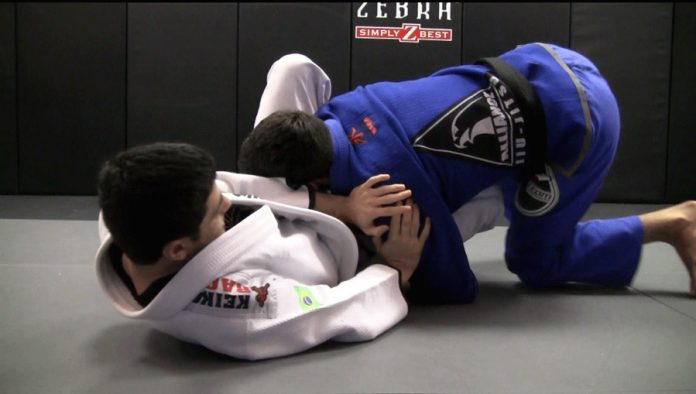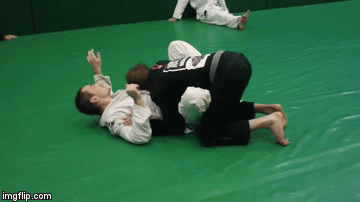
The butterfly guard is one of the most simple, yet effective open guard positions in Jiu-Jitsu. It is a tool that usually beginners and really advanced guys use. While between people seem to shun it because of its simplicity. However, getting stuck on the wrong side of it can quickly turn in to a Herculean task. As simple as it is, the butterfly guard is a notoriously hard one to pass. it’s easy for the bottom person to follow you with ease until they bait you enough to throw or submit you. As such, there is plenty of butterfly guard passes out there, but only few that work. Today, we’re going to categorize them for easier understanding and look at the most effective ones!
Passing the guard can be a really fun thing to do. In the natural progression of Brazilian Jiu-Jitsu, people usually start off from a guard position. This is new, easier to control and more likely to be effective. As people progress through the Gentle Art they tend to discover the pleasure of passing. Especially pressure passing. It works against even the stubbornest of guards, if and when you do it right. However, most of the conventional guard passing methods go straight out the window against a high-level butterfly guard. Butterfly guard passes are an art for mon their own. They need to be precise, quick and properly selected to fit the given circumstances.
Basically, the issue that butterfly guard passes face is directionality. the butterfly guard is set up in a manner which allows the opponent to move you in every direction possible. Even if you’\re standing, it’s not hard for an opponent to pull you straight back in, constantly hunting to send you flying. This can make passing the butterfly guard even more fun or it can frustrate you to the brink of madness. Depends on how good your opponent is, your understanding of the butterfly guard and the appropriate use of efficient passes.
Mr. Bernardo Faria is the ultimate source on pressure passing. Not only the butterfly guard but all kinds of guards you can imagine. Check out the “Pressure Passing Encyclopedia” DVD and become an unstoppable force from the top!
Butterfly Guard Dynamics
The butterfly guard is a fairly simple guard as far as structure goes. it is an open guard variety and falls under the “close distance” guards. However, the butterfly guard is a flexible position that easily adapts to plenty of distances. It works close and far, against a standing or kneeling opponent. The butterfly guard configuration itself is a defensive one. Its main attribute, which is our focus today, is preventing movement and passing sequences.
For a successful butterfly guard game, you need to have your hooks set up right and have upper body control via grips. Just resting your step on an opponent’s thigh is not going to do you any good from the bottom. You need to have your fingers pointing towards your knee and for the knees at about halfway between the mats and their top position. Against a kneeling opponent, both hooks need to go in. Against a standing one, a single hook is enough, with the other foot helping pivot you on the ground.
The butterfly guard does not work without grip, though. there’s no point in hooks without upper body control. Sleeve grips, sleeve and collar grips or two-on-one grips are the most usual ones. There’s also the option of double underhooks. Whatever the choice, the ultimate goal is to get under the hips of an opponent. Once there, sweeping is as easy as choosing a direction. the fact that all directions are open means you can send an opponent lying wherever you want. Even if they attempt to block, you can switch directions, systematically taking away their posting options until the fall. Or you could get into a leg lock, Guillotine choke or arm drag and back control at will.
Pressure Passing
Butterfly guard passes usually work in two major directions. You could either look to smash the guard’s structure an apply pressure passing, or stan up and go from there. For now, we’ll start with passing from the knees with the help of pressure.
First a few crucial pointers. When you’re looking to pass the butterfly guard from the knees, remember to first and foremost, break all grips on your arms. Next, the goal is to find the balance between pressure and mobility of your hips. Since the goal of the butterfly is to send you flying you need to have the opponent on their back. Next, you need to sit back as heavy as possible. Yet still, you need to be able to switch to floating hip movement the moment your opponent manages to elevate you. Remember that whenever your opponent has their legs too close to their butt, their butterfly guard won’t work.
-
Push Pass

-
Weave Pass

-
Leg Surfing

Standing Butterfly Guard Passes
Passing the butterfly guard form your feet is a daunting task. What you absolutely need to remember is that you can’t just stand upright. When butterfly guard passes from the knees don’t work, do not just stand up, or place just one leg up. The basics of trying to push the opponent’ legs to their but still apply here. Actually, the starting position is the same. Brak the grips, get the opponent on their back and control their biceps, putting pressure on them with the head and chest.
When all else fails, you’ll look to pass by raising your hips to increase pressure on the opponent and open up additional space. Remember that raising the hips is dangerous if you’re not controlling their legs. To that extent, you’ll need a grip on one foot whenever you decide to pass standing. Also, be aware that standing passes require some jumping and flipping around.
- Hip Switch Pass

-
Jump Over Pass



![Darce Choke Encyclopedia – Origins, Mechanics and Variations [2025] BJJ, choke, Brabo, BJJ Darce Choke, D'arce Choke, Darce BJJ Choke](https://bjj-world.com/wp-content/uploads/2017/11/JungPoirierLeeYahoo-218x150.jpg)









![No-Gi Grapplers Guide To Front Headlock Joel Bane DVD Review [2025] No-Gi Grapplers Guide To Front Headlock Joel Bane DVD Review](https://bjj-world.com/wp-content/uploads/2025/03/no-gi-front-headlock-joel-bane-dvd-review-218x150.png)

![Get Off My Legs Gringo Craig Jones DVD Review [2025] Get Off My Legs Gringo Craig Jones DVD Review](https://bjj-world.com/wp-content/uploads/2025/03/get-off-my-legs-gringo-craig-jones-dvd-review-218x150.png)

![Leg Lock Entries Helena Crevar DVD Review [2025] Leg Lock Entries Helena Crevar DVD Review](https://bjj-world.com/wp-content/uploads/2025/03/leg-lock-entries-helena-crevar-dvd-review-218x150.png)
![Special K Guard Neil Melanson DVD Review [2025] Special K Guard Neil Melanson DVD Review](https://bjj-world.com/wp-content/uploads/2025/03/special-k-guard-neil-melanson-dvd-review-218x150.png)

![Unpinnable Mount Escape Mastery Haleem Syed DVD Review [2025] Mount Escape Mastery Haleem Syed DVD Review](https://bjj-world.com/wp-content/uploads/2025/01/mount-escape-mastery-haleem-syed-dvd-review-100x70.png)



![Ginastica Natural Alvaro Romano DVD Review [2024] Ginastica Natural Alvaro Romano DVD Review](https://bjj-world.com/wp-content/uploads/2024/12/ginastica-natural-alvaro-romano-dvd-review-100x70.png)


![EMU Guard 2.0 Benjamin Power DVD Review [2024] EMU Guard 2.0 Benjamin Power DVD Review](https://bjj-world.com/wp-content/uploads/2024/11/emu-guard-2-0-benjamin-power-dvd-review-100x70.png)
![Leg Lock Stock And Barrel Taylor Pearman DVD Review [2025] Leg Lock Stock And Barrel Taylor Pearman DVD Review](https://bjj-world.com/wp-content/uploads/2025/03/leg-lock-stock-and-barrel-taylor-pearman-dvd-review-100x70.png)

![Intro To Hip Mobility for Guard Players Joshua Presley DVD Review [2024] Intro To Hip Mobility for Guard Players Joshua Presley DVD Review](https://bjj-world.com/wp-content/uploads/2024/09/hip-mobility-for-guard-joshua-presley-dvd-review-100x70.png)
![Wristlocks From The Top Pete Letsos DVD Review [2025] Wristlocks From The Top Pete Letsos DVD Review](https://bjj-world.com/wp-content/uploads/2025/01/wristlocks-from-the-top-pete-letsos-dvd-review-100x70.png)
![Mastering The Crucifix Alexandre Pereira DVD Review [2025] Mastering The Crucifix Alexandre Pereira DVD Review](https://bjj-world.com/wp-content/uploads/2025/01/mastering-the-crucifix-alexandre-pereira-dvd-review-100x70.png)



![Higher Tripod Passing Craig Jones DVD Review [2025] Higher Tripod Passing Craig Jones DVD Review](https://bjj-world.com/wp-content/uploads/2025/02/higher-tripod-passing-craig-jones-dvd-review-100x70.png)


![Special K Guard Neil Melanson DVD Review [2025] Special K Guard Neil Melanson DVD Review](https://bjj-world.com/wp-content/uploads/2025/03/special-k-guard-neil-melanson-dvd-review-100x70.png)
![Standing Leg Entries Alex West DVD Review [2025] Standing Leg Entries Alex West DVD Review](https://bjj-world.com/wp-content/uploads/2025/03/standing-leg-entries-alex-west-dvd-review-100x70.png)
![How to Double Leg Anyone Kevin Lee DVD Review [2024] How to Double Leg Anyone Kevin Lee DVD Review](https://bjj-world.com/wp-content/uploads/2024/11/how-to-double-leg-anyone-kevin-lee-dvd-review-100x70.png)
![Underhooks With Uncle Jeff Glover DVD Review [2025] Underhooks With Uncle Jeff Glover DVD Review](https://bjj-world.com/wp-content/uploads/2025/02/underhooks-with-uncle-jeff-glover-dvd-review-100x70.png)
![Jeff Glover DVD Bundle Review: Chokin’ Around With Uncle Jeff [2024] Jeff Glover DVD Bundle Review: Chokin' Around With Uncle Jeff](https://bjj-world.com/wp-content/uploads/2024/10/jeff-glover-dvd-bundle-review-chokin-around-100x70.png)




![Master The Move Anaconda Strangle John Danaher DVD Review [2025] Master The Move Anaconda Strangle John Danaher DVD Review](https://bjj-world.com/wp-content/uploads/2025/02/anaconda-strangle-john-danaher-dvd-review-100x70.png)